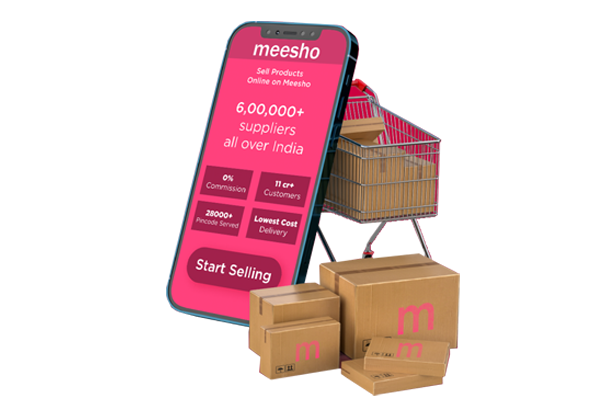Brand Overview
- Shopping ki power lo apne haath mein
- Lo aaya Meesho
Market Entry and Context
- When & why: Launched in 2015, Meesho entered at a moment when smartphone penetration and social apps (WhatsApp/Facebook) were exploding in India; founders built a lightweight “reseller” approach where small entrepreneurs marketed goods through social channels rather than discover items on large marketplaces.
- Unmet need: Large parts of India prioritised price, social trust and peer recommendations over brand storefronts; Meesho’s social-commerce / reseller model fit this behaviour and unlocked demand in smaller towns and among micro-entrepreneurs.
Marketing Mix (4Ps)
 Product Strategy
Product Strategy
- Reseller-first product: Tools that enable individuals (resellers) to create mini-shops, send catalogs via WhatsApp/social and take orders without owning inventory. This reduced the buyer acquisition cost and created a distributor-like network.
- Marketplace pivot: Over time Meesho became a full marketplace — onboarding suppliers, standardising listings, adding logistics and payments while retaining social discovery strengths.
- Value categories: Heavy focus on value-oriented categories (apparel, home & kitchen, FMCG adjacencies) where price sensitivity is highest.
 Pricing Strategy
Pricing Strategy
- Value-first proposition: Meesho competes on low gross prices rather than premium selection, positioning itself as the low-cost alternative for price-sensitive buyers. Senior industry commentary and Meesho’s filings highlight this “value commerce” play.
- Seller economics: The platform historically ran with little or zero seller commissions and monetised via logistics mark-ups, advertising and other platform fees — a deliberate choice to attract vast seller participation.
 Promotion Strategy
Promotion Strategy
- Performance + community: Heavy focus on word-of-mouth through resellers, app-level promotions, targeted digital ads, and app push/notification strategies.
- Localisation: Marketing and app UX optimised for regional languages and Bharat consumer moments; reseller success stories themselves acted as grassroots promotion.
 Distribution Strategy
Distribution Strategy
- Asset-light model: Meesho deliberately avoided owning large warehousing/logistics assets early on; it aggregated supply and routed orders through third-party logistics and partners to keep capital intensity low.
- Logistics & select asset plays: From 2024–25 Meesho built complementary capabilities (e.g., Valmo logistics) and tighter logistics partnerships to improve delivery economics and reliability ahead of its public listing.
Challenges and Response
- Quality & counterfeit risk: High order volumes from long tail sellers created increased counterfeiting and product quality risks; Meesho invested in delisting infra and policy enforcement.
- Unit economics & monetisation: Meesho’s low-commission model required alternative monetisation levers; the company expanded logistics services, ad products and selective asset plays to improve margins.
- Capital markets & IPO prep: Ahead of its 2025 IPO filing, Meesho restructured corporate domiciles, disclosed widening FY25 losses due to one-time restructuring costs and positioned for public scrutiny.
Competitive Landscape
- Primary rivals: Flipkart and Amazon (scale incumbents), which compete across assortment and logistics.
- Category and segment rivals: Social-commerce and value platforms (e.g., Glowroad earlier, social sellers) and direct brand D2C players in fast-fashion.
- Positioning advantage: Meesho’s reseller network and value focus create differentiation versus full-service incumbents who emphasise assortment, speed and brand partnerships.
Related Case Studies
Innovations & Adaptation
- Social commerce mechanics: Built-first integrations and UX for resellers to sell on WhatsApp/Facebook, lowering friction for offline entrepreneurs to go online.
- Ad tech & monetisation: Developed advertising products and logistics mark-ups to monetise at scale without charging seller commissions heavily.
- Scaling trust & safety: Large takedowns of counterfeit/restricted listings and Project Suraksha-style initiatives show investment in content moderation and policy enforcement as scale grew.
Consumer Perception & Cultural Connect
- Trusted value brand in Bharat: For many price-sensitive shoppers and reseller-entrepreneurs, Meesho became synonymous with low prices, entrepreneurship opportunity and access to a wide catalogue.
- Empowerment narrative: The brand often frames itself as enabling livelihoods (women micro-entrepreneurs, homemakers reselling), which resonated culturally and aided word-of-mouth in smaller towns.
Impact and Legacy
- Democratised commerce: Meesho brought tens of millions of micro-sellers into digital commerce, effectively expanding the retail ecosystem beyond traditional e-commerce buyers and brands.
- Value-commerce proof point: It established the commercial case that an asset-light, reseller-centric model can drive very high order volumes in India’s price-sensitive segments.
Key Learnings
- Design for the customer that exists: Meesho succeeded by designing for price-sensitive, social-first consumers and reseller sellers rather than copying full-service marketplaces.
- Asset-light can scale quickly — but governance matters: Low capital intensity accelerates growth, but scale brings quality and trust challenges that require investment.
- Monetisation must follow scale: If commissions are low, platforms must build alternative revenue (logistics, ads) as GMV rises.
- Localisation + livelihoods is sticky: Enabling entrepreneurship (esp. among women in smaller towns) builds durable word-of-mouth and distribution.
- Prepare for public markets: Scaling startups need transparent governance, tightened unit economics and a clear revenue mix before IPO scrutiny.
Summary
Meesho is a defining example of India’s value-commerce wave: a company that leveraged social apps, a reseller mindset and an asset-light marketplace to reach underserved customers and micro-entrepreneurs across Bharat. By FY2025 it had become one of India’s largest e-commerce platforms by users and order volumes, preparing for a major public listing while rebalancing monetisation, logistics and policy governance. Its legacy is both commercial (proving the reseller/value model) and social (creating small digital livelihoods), while its near-term test remains converting scale into sustainable profit and public-market credibility.





